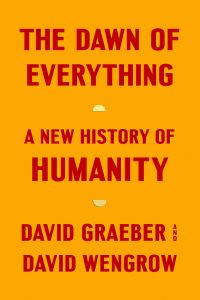The Dawn of Everything: A New History of Humanity – A Non-Linear Anarchist Reading of World History
 It’s an ideology that inspires fear and loathing in equal measure. Anarchism or the conviction that the state – and its pantheon of agents including potentates, scribblers, soldiers, and priests – is a parasite of society and inherently oppressive and evil – and wholly unnecessary as well.
It’s an ideology that inspires fear and loathing in equal measure. Anarchism or the conviction that the state – and its pantheon of agents including potentates, scribblers, soldiers, and priests – is a parasite of society and inherently oppressive and evil – and wholly unnecessary as well.
Power corrupts and absolute power corrupts absolutely. Perhaps Mao was right on at least one count: political power ultimately grows out of the gun barrel (or in times past, was delivered by the edge of a sword). The nation state, the highest form of political organisation, has been awarded an absolute monopoly over life and death and, as such, cannot escape its predestined fate. By design and conception, the state is corrupt. Thus spoke the anarchist.
The opposing argument holds that a stable and progressive civilisation needs structured order and organisation to grow and prosper – and, indeed, offer protection to its members: that being the state’s very raison d’être and why it was entrusted with monopoly powers. However, in practice that crucial state function – the suspension of the law of the jungle – is often a mere afterthought. Proof of the assertion that the state serves to protect against anarchy is said to be grounded in history. It is widely deemed indisputable.
The conventional reading of history postulates that humankind only embarked on a sustained and rapid trajectory of development after it shed the nomadic meanderings of prehistoric man and settled down to work the land and form communities. This first occurred in the Levant about 23,000 years ago. Here, Neolithic farmers domesticated and cultivated founder crops including barley, lentils, peas, flax, and emmer and einkorn wheat.
The Curse of the Land
Over the next ten or so millennia, agriculture arose independently in at least nine geographies from Mesoamerica to China, India, and Ethiopia.
Farming bound its practitioners to the land, resulting in the appearance of the first semi-sedentary societies such as the Natufian Culture that stretched northwards from the edge of the Negev Desert to present-day Lebanon, Jordan, and Syria.
Tell Abu Hureyra, an archaeological site in Syria’s Upper Euphrates Valley, provides the earliest solid evidence of agriculture in the world. The first evidence of bread-making, dating from about 12,500 BCE, was found at Shubayqa, a site in north-eastern Jordan.
However, the first ‘proper’ civilisation was formed eight millennia ago when Sumerians agglomerated in villages throughout the Fertile Crescent and eventually invented the plough and figured out how to brew beer, completing the Neolithic Revolution and, incidentally, setting the stage for much human suffering and bondage.
However, farming was not an agent of steady and unequivocal progress. Ethnological and archaeological research warrants the conclusion that hunter-gatherers enjoyed longer lives and more robust health than their settled fellow man. Due to chronic malnutrition (caused by frequent crop failures) and the advent of new diseases, the average height of pioneering farmers dropped 13cm to 165cm for men and 155cm for women. Shockingly, average height only returned to its pre-Neolithic Revolution level in the mid-twentieth century. The paleo diet turned out to be not so bad after all.
Upending the Narrative
In Guns, Germs, and Steel: The Fates of Human Societies[1] transdisciplinary historian Jared Diamond concludes that Europeans and East Asians leveraged their comparatively advantageous environment to become early adopters of agricultural sedentary lifestyles which, over time, brought the food surpluses that allowed some people to specialise in pursuits other than mere sustenance.
This division of labour inevitably led to technological innovation – free time being a terrible thing to waste even amongst the ancients – such as the steel swords and firearms that enabled these societies to expand their reach by conquering neighbouring lands, thus forming embryonic empires.
The struggles of mankind in its relentless chase of progress and the inescapable coveting of the neighbour’s riches may, however, have been in vain insofar that states as an expression of politics (derived from the Greek politikos, literally “affairs of the city”) have likely hindered the pursuit more than helped.
Such is the rather remarkable premise of The Dawn of Everything: A New History of Humanity[2], a 700-page doorstopper, and page-turner, that seeks to upend the orthodox narrative of social evolution as espoused and propagated by Mr Diamond and the recently fashionable Yuval Noah Harari – and 99.9% of their fellow broad-stroke historians.
Genius Interrupted
The late David Graeber, co-author of The Dawn of Everything, was without doubt one of the most original social thinkers of our time. He wrote several books such as the bestseller Debt: The First 5,000 Years[3] and is credited with inspiring the Occupy Movement on both sides of the Atlantic – and coined its slogan ‘We Are the 99%’.
His death on 2 September 2020, at the age of 59 during a vacation in Venice, may hint at echoes from Thomas Mann’s 1912 novel but also deprived the world of a magnificent genius – a truly beautiful mind – with an uncanny knack for punching big holes in established thought bubbles, invariably deflating them to near-irrelevance.
Mr Graeber made many of his fellow academics uncomfortable. Yale University, where he held an associate professorship in Anthropology from 1998 to 2005, is suspected to have blocked his path to full tenure over political concerns. Mr Graeber, an unapologetic anarchist, moved to the University of London Goldsmiths College instead before finding an academic home at the London School of Economics.
Mr Graeber’s premise is straightforward: progress is non-linear and other paths of social evolution, much less trodden, may well lead to similar if not better outcomes. In a nutshell: the state and its agents are quite superfluous to human requirements.
Noble Savage
Before dismissing Mr Graeber as woolly-minded or worse, consider that his thoughts and considerations are, essentially, part of the philosophical framework first sketched and delineated by Jean-Jacques Rousseau in his 1754 tract on the origin of social inequality[4].
The French-Swiss philosopher exhaustively studied the journals of mariners returning from the first voyages to the New World. The seamen were astonished to have encountered an idyllic, almost paradisiacal, egalitarian society without princes, cardinals, or warlords and where work seemed optional because nature provided for human needs in abundance. Although he never used the phrase in his own discourse, Rousseau did paint a vivid picture of the Noble Savage: “Once upon a time we were hunter-gatherers, living in a state of childlike innocence, as equals.”
This happy condition, Rousseau noted, came to an end after the agricultural revolution and the rise of cities. Paradoxically, urban living sparked literature, science, and philosophy but also patriarchy, bureaucracy, taxation, armies, and the exclusion or execution of non-conformists.
As a concept, the noble savage may first have been used by the Roman politician and historian Tacitus whose Germania[5] (De origine et situ Germanorum) rather lyrically describes the lands and customs of Germanic tribes in the “uncivilised” wilderness beyond the empire’s borders.
Less historically distant sits Spanish priest (later bishop of Chiapas) Bartolomé de las Casas (1484-1566) who thundered at the inhumane treatment of the indigenous peoples of the Americas in his Short Account of the Destruction of the Indies[6]. Bishop De las Casas praised the “simple manners” of native Americans and observed that they were incapable of lying or deceit.
His participation in the landmark Valladolid Debate (1550-51), the first one in Europe to discuss the rights and treatment of indigenous people by colonisers, led to a further weakening of the “encomienda” system – which rewarded colonists and conquerors with the labour of subjected non-Christian people – and its replacement by somewhat less brutal “reducciones” that ushered natives – often forcefully – into towns where missionaries would dispense lessons in Christian morality whilst exploiting their labour.
Much later still, French structuralist anthropologist and reluctant explorer Claude Lévi-Strauss lamented the “loss of innocence” in the New World after its involution in the European chrysalis. His 1955 travelogue Tristes Tropiques[7] blends astute ethnological observation with philosophical musings and tentatively concludes that “deeper poverty and spiritual emptiness” are to be found on the streets and in the houses of “our”modern cities.
Exit Rulers
Mr Graeber departs from well-established tradition with his assertion – backed up by a vast reservoir of proof – that “nobles savages” built large cities and engaged in complex collaborative pursuits; all without the need for rulers – or indeed rigid rules.
Messrs Graeber and Wengrow point to a wealth of archaeological discoveries made over the past few decades – thus far mostly confined to scientific journals – to show that many of the earliest known cities were structured along egalitarian lines. Neolithic urbanites apparently lived for centuries without the need to elevate some to lofty positions of power and privilege. The remarkable absence of palaces, temples, or other grandiose buildings – and of evidence of a ruling caste or stratum – strongly suggests self-government.
In other places, palaces and temples were only built much later. The first large cities – with tens of thousands of inhabitants – emerged in Mesoamerica which enjoyed neither the technical nor the logistical advantages of Eurasia. Here, there were no wheeled conveyances, nor ships, or animal-traction. Moreover, metallurgy was poorly developed.
These cities should not have been. Conventional wisdom holds that advances in agriculture, producing surplus wealth, set off a chain of discoveries that allowed larger groups of people to live and work in one place. In other words: technology enabled, but invariably predated, the formation of larger cities. However, that was decidedly not the case in tech-poor Mesoamerica or along the eastern fringes of Europe.
Civic Pride
Excavations have repeatedly shown that early self-governing cities were much more than an agglomeration of self-centred individuals and did, in fact, cultivate a sense of civic pride and unity. Most early cities appear carefully laid out in harmonious patterns and with clearly identifiable districts, reflecting a high degree of urban planning – a distinctly collaborative effort.
How such large populations centres may have been held together without kings, bureaucrats, and soldiers mystified historians until 2014 when new conclusive research showed that the Cucuteni-Trypillian settlement unearthed forty years earlier near Maidanetske, a farming village about 240km south of Kyiv in Ukraine, was much larger than initially suspected, holding a population of up to 46,000 people around 3700 BCE – making it by far the largest city of that era.
Scholarship Disrupted
The steppes north of the Black Sea – now a battlefield – are home to many archaeological digs that disrupt established scholarship. Ignoring recent findings and research, many concerned academics prefer to speak euphemistically of “mega-sites” rather than mega-cities.
A few learned historians, most perturbed by the potential undermining of their narrative, call Maidanetske and sister sites such as nearby Talianki and Nebelivka “overgrown villages” before quickly moving on to Uruk, the ancient mega-city of Sumer (present-day Iraq) which was at least properly ruled by sovereigns during the Early Dynastic Period, such as the legendary King Gilgamesh.
Meticulous analysis by archaeologists show that the oval-shaped cities or sites of Ukraine flourished between 4100 and 3300 BCE and produced sizeable surpluses. That offered ample opportunity for some of the cities’ more enterprising residents to lord over their neighbours. Yet, there is no proof of that.
Instead, the citizens built assembly buildings and kept communal gardens that produced pears, cherries, apples, apricots, acorns, and hazelnuts – served on painted ceramics that are considered among the finest aesthetic creations of the prehistoric era. They also imported salt, flint, and copper from afar.
Village Simpletons
There is plenty of evidence that suggests early Ukrainian city dwellers enjoyed social freedoms maintained through local and neighbourhood decision-making processes that dispensed the need for top-down administration. After about eight centuries, the Neolithic cities of Ukraine and Moldova were abandoned for reasons still unknown. Their legacy is nonetheless important for these cities show that an egalitarian society is possible on an urban scale.
The urge to write off societies without kings, priests, or generals as “simple” has been prevalent throughout history. Indeed, the noble savage himself is but an inoffensive simpleton and weakling. He may be depicted as quite happy but is often also considered rather ignorant and singularly unable to create great works of art, defy gravity with grand buildings, or invent ingenious machines that lighten man’s burden. Of course, the noble savage carrying no burden had no need for such machines to begin with.
The findings in Ukraine and Moldova coincide with similar ones in Mesoamerica (Teotihuacan) and in China’s Shandong Province where large urban settlements were present well over a thousand years before the rise of the earliest known royal dynasty.
The narrative of most broad-stroke historians rests on the presumption of linear progress. In this reading, the first 300,000 or so years of human history were rather uneventful. Hunter-gatherers lived in small groups until – at last! – agriculture and sedentary societies gradually appeared to give rise to states organised along hierarchical lines and based on the exploitations of labour.
Messrs Graeber and Wengrow reject the notion that early humans were nothing more than automatons prodded and guided by material pressures. Instead, they argue that “primitive man” experimented with a “carnival of political forms” and possessed plenty of agency. The idea that history resembles a conveyor belt that takes humankind from the Serengeti wilderness straight into the office cubicle is overdue for reassessment.
The Indigenous Critique
But how are we to know what really happened in the far reaches of history? Can archaeology truly decipher the intricacies of prehistoric political life? Writing in The Nation, historian Daniel Immerwahr called David Graeber a “wildly creative thinker better known for being interesting than being right.” However, a feeble attempt by Immerwahr to discredit one of the book’s claims fell flat after he read the source wrong.
Yale University political scientist James C Scott said that Graeber and Wengrow have probably delivered a “fatal blow” to the traditional reading of early history but also warned that academia does not usually embrace dissidents – or kindly accept the conclusions of their research.
Mr Scott challenged the standard narrative in his own Against the Grain: A Deep History of the Earliest States[8], published in 2018, which ruffled feathers by looking at the formation and emergence of states through the eyes of sceptical peasants. He likewise concludes that the causal sequence of history’s standard version is demonstrably wrong.
Perhaps the most interesting and striking part of The Dawn of Everything is delivered in an early chapter on The Indigenous Critique which, the authors argue, is likely to have helped spark the European Enlightenment.
The critique, formulated by natives of the New World and recorded by French explorers, posited that for all their technological advances and prowess, the great powers of Europe had failed to promote the freedom, wellbeing, and happiness of their people. As such, the critique questioned the purpose and usefulness of the state as a political construct.
In a sense, the flash-in-the-pan Occupy Movement asked the exact same question – and it is a serious one that demands pondering. According to David Wengrow, the present moment invites reflection: “Our prevailing system is putting us and the planet on a course of real catastrophe. We find ourselves paralysed with our horizons closed off by false perspectives of human possibilities based on a mythological conception of history”
By Wim Romeijn
[1] Guns, germs, and Steel: The Fate of Human Societies by Jared Diamond. WW Norton & Co. 1997. 480pp, out of print, ISBN 978-0-3930-3891-0
[2] The Dawn of Everything: A New History of Humanity by David Graeber and David Wengrow. Farrar, Straus and Giroux 2021. 704pp, hardcover, $26.49, ISBN 978-0-3741-5735-7
[3] Debt: The First 5,000 Years by David Graeber. Melville House 2011. 544pp, out of print, ISBN 978-1-9336-3386-2
[4] Discourse on the Origin and the Foundations of Inequality Among Men by Jean-Jacques Rousseau. Createspace Independent Pub 2017. 96pp, print on demand, paperback, $11.95, ISBN978-1-9793-1632-3
[5] Agricola and Germania by Tacitus. Penguin Classics 2010. 121pp, paperback, $11.99, ISBN 978-0-1404-5540-3
[6] Short Account of the Destruction of the Indies by Bartolomé de las Casas. Penguin Classics 1999. 192pp, paperback, $14.29, ISBN 978-0-1404-4562-6
[7] Tristes Tropiques by Claude Lévi-Strauss. Penguin Classics 2012. 448pp, paperback, $21,49, ISBN 978-0-1431-0625-8
[8] Against the Grain: A Deep History of the Earliest States by James C Scott. Yale University Press 2018. 336pp, paperback, $15.49, ISBN 978-0-3002-4021-4
You may have an interest in also reading…
Fortress Russia on Shaky Ground: EU Finds Its Footing and Unleashes Its Economic Might
The rouble took a pounding of note, losing almost a third of its value as soon as forex markets opened
Why are US Conservatives Against Investment in ESG?
Republicans balking at ‘woke liberal agenda’ that they claim could erode profit margins and threaten livelihoods US politicians are treating
The First Days: The Need for Speed in US Politics
In his inauguration speech, President Joe Biden called US democracy precious and fragile: “And at this hour, my friends, democracy


















































































